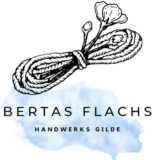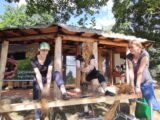Sweden's way to strengthen (art) craftsmanship
I'm a little envious - in three days I got an insight into the textile activities of Marie Ekstedt Bjersing and Christin Wahlström ErikssonI have a beautiful
Linen exhibition in the Rydals visited, in the Gunnebo Castle I spoke to the restorer and was able to marvel at Helene's family's experimental flax cultivation and their many old tools. Again and again I got the strong impression that there is a completely different attitude towards (old) crafts in this country. In contrast to Austria, people here at least try not to put any additional obstacles in the way of artists and offer a lot of low-threshold help with networking.
Of course, it's never easy when you dedicate yourself to something that is no longer there and that needs to be brought back with energy and research, that takes a lot of time and is therefore rarely or cannot be adequately remunerated, and that serves the niche rather than the masses. However, Sweden is taking a path that motivates people to engage with arts and crafts on many different levels.
27 varieties of flax
We visited Helena, Tommy and their son Gustav on the first day of our stay in Gothenburg. They not only run a small Strommared organic fruit farmbut also experiment with many different old flax varieties. The NordGEN seed bank has 27 different old flax varieties, which are propagated by the family at two different locations and adapted to the local climate. The starting point for the trial was again the project 1 kvm lin - 1 m2 flax (more about this project), for which they now want to use local varieties instead of industrial ones. Helena has also set up a barn with various hand tools and is networking with many flax enthusiasts with her family. This is all possible because there is active help from the government for this type of work here, namely network offices for handicrafts, which take on a lot of administrative work, provide advice and help with implementation. In this way, creative people can do exactly what they do best, namely be creative.
Arts and crafts at the university
Another indication that (arts and) crafts have a completely different status in Sweden is the way they are anchored in schools and universities. Handicraft lessons are not an unloved appendage in compulsory schools, but a fairly comprehensive subject, and handicrafts can also be studied at universities. Even in degree programmes that are primarily concerned with machine processing, the basis, namely handicrafts, is a compulsory course. There is funding for research and schools such as Saterglantanwhich offer recognised arts and crafts training courses.
Craftsmanship will always be a "hard job", but with the path Sweden is taking, we have the chance to preserve old techniques and make the younger generation want to learn craftsmanship.









2 Replies to “Schwedens Weg das (Kunst)handwerk zu stärken”
Thank you for the detailed report and the beautiful pictures. However, it would have been much more interesting to provide detailed photos and an exact description of how such a "flat hammer" or "oscillating wheel" is constructed and functions, as we don't have anything like that here. Perhaps this could be added.
MfgMonika
Dear Monika, Unfortunately we were already in the low season at the Flachshammer and all the houses were closed. I collected all the information from the few information boards and translated it. Unfortunately, there's no more than what I've posted. But of course it would be nice to come back when the Hammer is running and something is being demonstrated